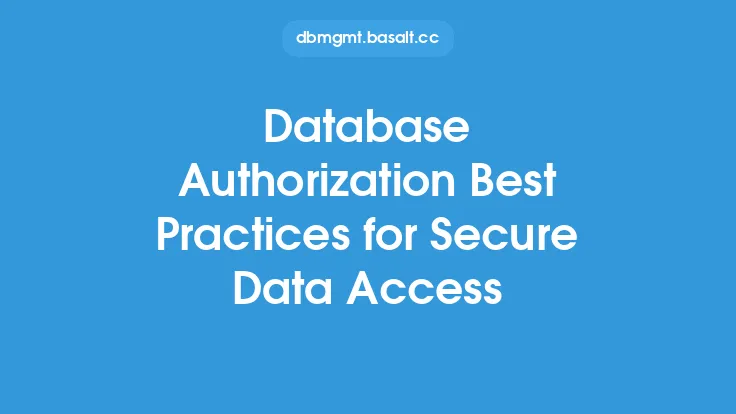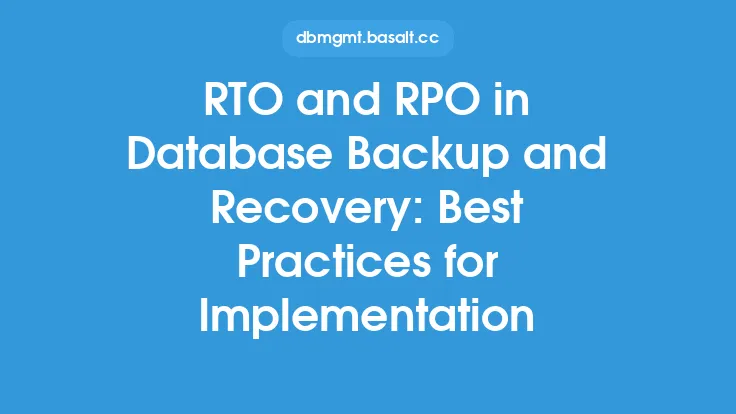Implementing effective database access control is crucial for protecting sensitive data and preventing unauthorized access. Database access control refers to the mechanisms and policies that regulate who can access, modify, or delete data within a database. In this article, we will delve into the best practices for implementing database access control, highlighting the key considerations, techniques, and tools that can help organizations ensure the security and integrity of their databases.
Introduction to Database Access Control
Database access control involves a set of rules, procedures, and mechanisms that govern access to database resources, including data, schema, and database management system (DBMS) functionality. The primary goal of database access control is to prevent unauthorized access, ensure data confidentiality, integrity, and availability, and comply with regulatory requirements. Effective database access control requires a combination of technical, administrative, and physical controls, which must be carefully planned, implemented, and maintained.
Authentication and Authorization
Authentication and authorization are two fundamental components of database access control. Authentication verifies the identity of users, while authorization determines the level of access granted to authenticated users. Strong authentication mechanisms, such as multi-factor authentication, can help prevent unauthorized access. Authorization, on the other hand, involves assigning permissions and privileges to users or groups, which can be based on roles, responsibilities, or other factors. It is essential to implement a robust authorization framework that can enforce fine-grained access control, including row-level security and column-level security.
Access Control Models
Several access control models can be used to regulate access to databases, including discretionary access control (DAC), mandatory access control (MAC), and role-based access control (RBAC). DAC grants access based on user identity and ownership, while MAC enforces access control based on sensitivity levels and clearances. RBAC, on the other hand, assigns access based on roles and responsibilities. Each model has its strengths and weaknesses, and the choice of model depends on the specific requirements and constraints of the organization.
Implementing Least Privilege Access
The principle of least privilege access states that users should be granted only the minimum level of access necessary to perform their tasks. Implementing least privilege access requires careful analysis of user roles, responsibilities, and requirements. It involves assigning limited privileges, restricting access to sensitive data, and monitoring user activity to detect and prevent potential security breaches. Least privilege access can be enforced through various mechanisms, including role-based access control, attribute-based access control, and mandatory access control.
Auditing and Monitoring
Auditing and monitoring are critical components of database access control, as they help detect and respond to security incidents. Auditing involves tracking and recording all access attempts, including successful and unsuccessful logins, data modifications, and other security-relevant events. Monitoring, on the other hand, involves real-time analysis of audit logs and system activity to identify potential security threats. Effective auditing and monitoring require careful configuration of audit trails, log analysis tools, and alerting mechanisms.
Encryption and Data Masking
Encryption and data masking are essential techniques for protecting sensitive data in databases. Encryption involves converting plaintext data into unreadable ciphertext, while data masking involves hiding sensitive data from unauthorized users. Encryption can be applied to data at rest (stored data) or data in transit (data being transmitted). Data masking, on the other hand, can be used to hide sensitive data, such as credit card numbers or personal identifiable information (PII). Effective encryption and data masking require careful key management, encryption algorithm selection, and data masking policy implementation.
Compliance and Regulatory Requirements
Database access control must comply with various regulatory requirements, including the General Data Protection Regulation (GDPR), the Health Insurance Portability and Accountability Act (HIPAA), and the Payment Card Industry Data Security Standard (PCI DSS). Compliance requires careful analysis of regulatory requirements, implementation of relevant controls, and ongoing monitoring and auditing. Organizations must also ensure that their database access control mechanisms are aligned with industry standards and best practices, such as the National Institute of Standards and Technology (NIST) Cybersecurity Framework.
Best Practices for Implementation
Implementing effective database access control requires careful planning, execution, and maintenance. The following best practices can help organizations ensure the security and integrity of their databases:
- Implement strong authentication and authorization mechanisms
- Enforce least privilege access and role-based access control
- Use encryption and data masking to protect sensitive data
- Implement auditing and monitoring mechanisms
- Comply with regulatory requirements and industry standards
- Regularly review and update access control policies and procedures
- Provide training and awareness programs for users and administrators
- Continuously monitor and analyze audit logs and system activity
Tools and Technologies
Various tools and technologies can help organizations implement and manage database access control, including:
- Database management systems (DBMS) with built-in access control features
- Identity and access management (IAM) systems
- Access control software and appliances
- Encryption and data masking tools
- Auditing and monitoring software
- Compliance and regulatory management tools
- Cloud-based access control services
Conclusion
Database access control is a critical component of database security, and its effective implementation is essential for protecting sensitive data and preventing unauthorized access. By following best practices, using appropriate tools and technologies, and complying with regulatory requirements, organizations can ensure the security and integrity of their databases. Ongoing monitoring, analysis, and improvement of access control mechanisms are also crucial for maintaining the security posture of databases and preventing potential security breaches.





